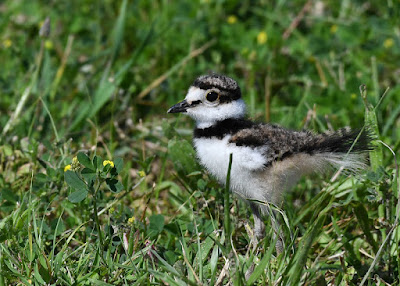 |
| Killdeer / Photo by Grayson Smith/USFWS |
- Black-backed Woodpeckers nest around the edges of burned patches, and climate change is reducing that type of habitat by making fires larger and more intense.
- Kirtland's Warbler has recovered sufficiently that it no longer needs protection from Brown-headed Cowbirds. Some habitat management to maintain young Jack Pine forests will still be necessary.
- Northern Spotted Owls are continuing to decline in Mount Rainier National Park, and their territories are being taken by Barred Owls.
- Kinder Morgan wants to build a pipeline through the heart of the Golden-cheeked Warbler's breeding range.
- The Interior Department has increased drilling and leasing in areas that had been set aside as priority conservation areas for sage grouse.
- Piping Plover breeding colonies have been more successful in New York than in North Carolina. Colonies in North Carolina have depended on attracting plovers hatched elsewhere to maintain their numbers, while colonies in New York keep growing.
- Fossils of the largest parrot ever recorded were recently identified in New Zealand. The parrot probably stood about three feet tall and lived in the Miocene.
- Here is an interview with two scientists working to protect hornbills in Indonesia. The country is home to 13 hornbill species, which are threatened by habitat destruction and the wildlife trade.
- A review by BirdLife identified the biggest threats to seabirds as invasive species (at nesting sites), bycatch, and climate change, but which threat is most significant varies by seabird species. For albatrosses, bycatch is the biggest threat, but penguins are more threatened by climate change.
- Seabird chicks can be harmed by even a few pieces of plastic.
- A study of Herring Gulls found that they were less likely to steal food if someone was watching them.
- Vultures have an important niche despite some misconceptions about them.
- One site in Cambodia is home to five critically endangered bird species: two ibises and three vultures.
- The Meadowlands Nature Blog: Don Torino’s Life In The Meadowlands: What Makes A Great Birder?
- Avian Hybrids: These two White-eye species should be hybridizing, but they don’t…
- Bird Ecology Study Group: Black-thighed Falconet – courtship behaviour
- Vermont Center for Ecostudies: Field Guide to August 2019
- Research on the Bass Rock gannets: Sex differences in gannet migration and demography – new paper out!
- BugTracks: Sharing the Fruit Trees
- The Western Conifer-Seed Bug is native to North America but invasive in Chile, where it causes alarm if mistaken for a kissing bug, which transmits Chagas disease.
- Activists are seeking federal endangered listing for Photuris bethaniensis, a rare firefly found only in coastal Delaware. Some of its habitat is currently threatened by a housing development.
- Firefly and Monarch numbers appear to be higher this summer than in past years in Ontario.
- New Zealand has announced a new plan to protect and restore its native biodiversity.
- Here is an interactive about what it feels like to be a bee.
- The US Fish and Wildlife Service is pushing back against the latest proposed border wall extension, which would run through Cabeza Prieta and San Bernadino National Wildlife Refuges and cause significant habitat destruction.
- A new UN report warns about the threat climate change poses to the world's food supply.
- Alaska recorded its warmest month ever this July, and there is no sea ice within 150 miles of its coast.
- The Forest Service is seeking to reduce or eliminate public comment periods for management actions in national forests.
- Climate change and failing infrastructure are worsening algae blooms like the one affecting Lake Hopatcong this summer.



